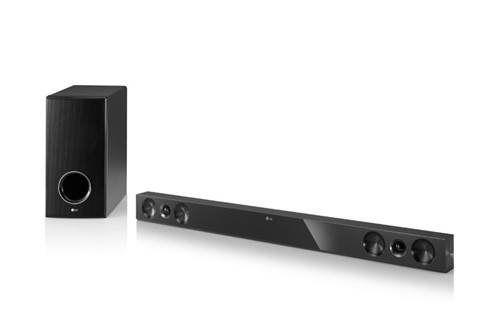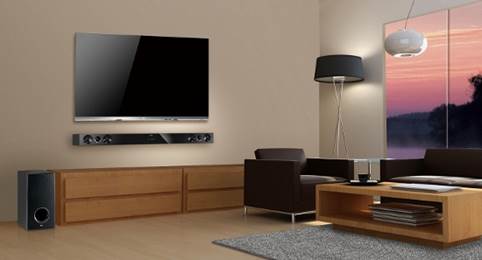Fed-up with inferior flat screen
sound? Improve your sonic satisfaction with an affordable sound bar solution
It’s visual appeal that counts most when
buying a TV, from the slinkiness of the frame to the eye-popping quality of the
HD images. In the quest to make screens ever thinner and less physically
imposing audio remains very much an after-though. Consequently, the sound
quality from built-in TV speakers is not much better than the radio cassette
player in a 1970s’ Ford Cortina. No flat screen on the planet wouldn’t benefit
from a bit of sonic stimulation.
A sound bar is the simplest way of getting
aurally sorted but the market is complex. Factors that need to be considered
include connectivity, format handling, power output and whether or not you want
a separate subwoofer. The latter can make a substantial difference to your
enjoyment and the trend of r wirelessly connected subs makes it a lot easier to
keep your living room looking neat and tidy. The physical size of a sound bar
can be critical if you’re intending to use it on a TV stand rather than use a
wall-mount. As for connectivity, hi-res audio decoding requires HDMI inputs, a
feature beyond the scope of this test, but not a fatal omission, given that by
their very nature sound bars can’t deliver a genuine 7.1 sound field. Also, all
of these models can still handle Dolby Digital and DTS digital surround sound
formats.
This test consists of four models ranging
in price from $225 to $525 and our aim was to find out how performance and
convenience vary across that fiscal spectrum. We put the bars through their
sonic paces by using a range of test material including the viscerally exciting
DTS-HD tracks of Band of Brothers and Twilight, Mozart’s sublime Violin
Concerto in D Minor, a DTS recording of Talking Heads’ thumping Life During
Wartime and a selection of TV broadcasts on Sky.
Buying tips
The height of a sound bar can be critical
when mounting it on the same stand as your TV. Too tall and it may impinge on
the visibility of your screen
Always ask for a demonstration, which will
show that manufacturer claims about power output can be taken with a
cellar-full of salt
Check the digital connections. Optical
inputs are common on sound bars, whilst coaxial outputs dominate Blu-ray decks
Bose solo TV sound system

Bose
solo TV sound system
Ratings
Plus
·
Simple to use
·
Can be used as a base under a TV stand
·
Copes well without a sub
Minus
·
Only one input allowed at a time
·
Better at music than movies
·
Footprint too small for many TVs
·
Build: 8 stars
·
Setup: 9 stars
·
Performance: 8 stars
·
Features: 7 stars
·
Value: 7 stars
·
Overall: 78%
Strictly speaking, the Solo is not a sound bar,
due to its shape. In terms of functionality, it is nothing but.
You can’t help but think that Bose’s
decision to design the Solo in the shape of a (rather ordinary looking) deck or
PVR is both inspired and flawed. Inspired because it means a TV can be placed
directly on its top surface, flawed because many TV stands have larger
footprints than the Solo’s dimensions (51cm wide x 26cm deep).
Features-wise the Solo is a simple
proposition but like the Orbitsound, it impresses by offering a coaxial audio input
as well as optical and stereo analogue phonos. However, our joy is tempered
slightly by the fact that you can only have one input physically hooked up at a
time. User information and operation is typical Bose minimalism, with just a
single LED light that glows and blinks according to the unit’s status. The
remote control has only four buttons, for controlling power and volume.
With no subwoofer, no display on the
fascia, no DSP modes, and no way of adjusting the quality of the sound the Solo
is aimed at the armchair enthusiast who simply wants a better sound and doesn’t
want to spend time playing around with setting according to the source. It’s a
risky strategy but is not without merit, especially when the results are as
good as they are here/
The battle scene of Narnia is engaging and
the Bose produces plenty of low-end grunts. In Band of Brothers there’s a strong
sense of refinement and dialogue has good clarity. In both movies certain
high-end effects sound a little clipped, such as sword clashes and bullet
swooshes. The dialogue of Mad Men is rich and satisfying.
Musically, the Solo really gets going,
taking Talking Head’s tricky Life During Wartime in its stride, surprisingly
keeping a lid on the thump of the drum-heavy mix.
LG NB3520A
Ratings
Plus
·
Versatile but easy to use
·
Generally impressive audio
·
USB and Bluetooth playback
Minus
·
Different sources require tweaking
·
Not so adept at music
·
Artificial sound
·
Build: 8 stars
·
Setup: 8 stars
·
Performance: 7 stars
·
Features: 9 stars
·
Value: 8 stars
·
Overall: 80%
LG’s NB3520A is reassuringly solid and
attractive which is just what a sound bar should be. At 8cm tall, it fits
neatly under most flat screen TVs even on a tabletop, but its 100cm width may
look odd with smaller screens and be too wide for some TV stands.

LG
NB3520A
It’s more convenient than a corner shop,
offering a wireless sub, which can be tucked away behind the sofa and handily
connects to the sound bar of its own volition. There is also playback of MP3s
from USB flash drives and streaming from Bluetooth devices. This model may lack
HDMI (and hence high resolution DTS HD MA decoding) but that’s acceptable at
this price, and compensation comes in the form of dual optical inputs as well
as a 3.5mm jack. Double optical inputs mean you can take advantage of surround
sound decoding from say a Sky box or TV as well as a DVD or Blu-ray deck.

LG’s
NB3520A is reassuringly solid and attractive which is just what a sound bar
should be
The remote control is chunky by sound bar
standards but well laid out and packed with buttons. An LED display on the
sound bar itself clearly indicates the playback and mode status, with eight DSP
modes available. It’s worth playing with these, as well as adjusting the
subwoofer level and trying the (pseudo) 3D effect button as the NB3520A is more
than capable of delivering excellent sound. It seems more at home with movies
and drama than music, thanks to its pit-bull of a subwoofer that draws up to
26W of power at times. Band of Brothers’ cacophonous DTS soundtrack is immensely
powerful, yet nicely controlled so that dialogue remains clear and bullets
whizz around energetically and distinctly. With music the subwoofer need
reigning in from swamping the mid-range with Talking Heads’ Life During
Wartime. Mozart’s Violin Concerto in D Major by Marianne Thorsen is bright and
lively but remains a tad artificial. Bluetooth and USB playback are both
pleasingly simple to set up and operate but it struggles to smooth over the
cracks in inferior MP3 music files.